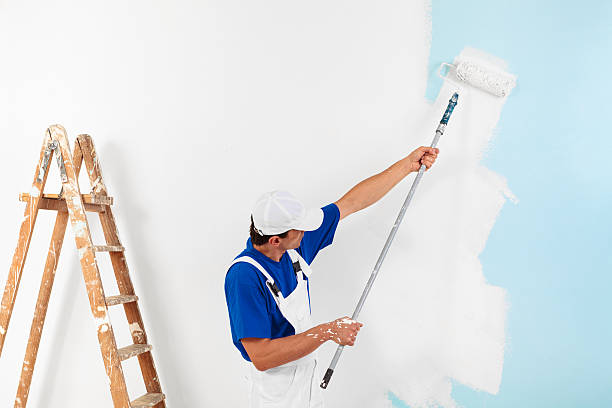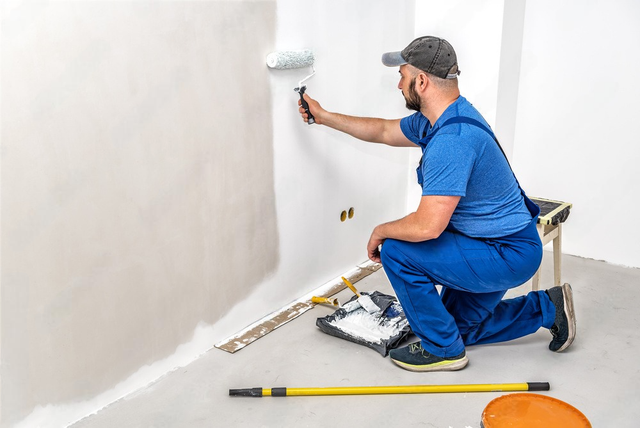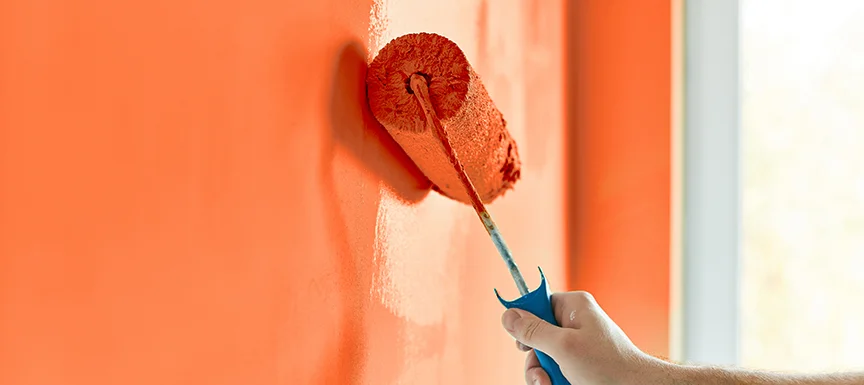Stay Ahead With New Paint Trends: Mixing Strategies for Modern Interiors

The Surge of Shade Gradients in Interior Decoration
As developers progressively look for innovative means to enhance rooms, the increase of shade slopes in interior decoration has amassed substantial interest. This technique, defined by the smooth shift in between 2 or even more colors, enables a vibrant visual effect that can change a regular space right into a lively atmosphere. Color slopes can stimulate feelings, affect perceptions of room, and create prime focus, making them a flexible selection for numerous layout styles.
The application of gradients prolongs beyond wall surfaces; they can be successfully employed in furniture, textiles, and accessories. Designers commonly explore differing tones to accomplish depth and intrigue, appealing to a variety of aesthetics from minimal to diverse. In enhancement, the versatility of slopes allows their use in both industrial and household settings, dealing with varied clientele. As patterns advance, the usage of shade slopes represents a change towards more personalized and meaningful indoor spaces, mirroring specific tastes and way of lives.
Accepting Ombre Strategies for a Dynamic Look
Ombre methods have actually become a captivating selection for those seeking to add depth and activity to modern-day interiors. This gradient result changes smoothly from one shade to an additional, creating an aesthetically striking prime focus in any type of space. Designers appreciate ombre for its flexibility; it can be applied to walls, furniture, and even decorative accents, permitting one-of-a-kind expressions of style.
The technique works especially well with soft shades, providing a peaceful setting, while strong shades can energize an area. Home owners can explore different color schemes, selecting contrasting shades for a dramatic influence or harmonious tones for a subtle effect. The application of ombre is not restricted to a solitary wall; it can extend throughout a room, enhancing the perception of area and light.
As a contemporary fad, ombre techniques cater to varied preferences, allowing individuals to customize their insides and accept creativity in their layout strategy. corpus christi paint store.
Textured Walls: Layering Paint for Deepness and Rate of interest
Textured wall surfaces can substantially enhance the visual allure of modern interiors by including depth and interest. Techniques for creating texture, thoughtful shade combinations, and the right tools for layering are necessary parts in achieving this impact. Exploring these aspects enables a vibrant and individualized technique to interior decoration.
Methods for Appearance Production
Developing visual rate of interest in indoor rooms often depends upon the artful application of appearance. Different techniques can be utilized to achieve this, such as sponging, rag rolling, and stippling. Sponging includes making use of a moist sponge to use a second shade over a skim coat, producing a soft, varicolored impact. Cloth rolling, on the various other hand, utilizes a rolled rag to use paint, resulting in a much more dynamic appearance. Stippling utilizes a tight brush or tool to dab paint onto the surface, producing a distinct pattern. In addition, layering various coatings, such as matte and shiny, can enhance depth. These methods not just offer visual charm yet additionally add to the total setting of modern-day interiors, motivating a responsive experience.
Shade Mixes for Impact
Layering paint not only improves appearance however additionally opens a globe of color mixes that can drastically affect the mood of an area. By mixing complementary tones, developers can create a harmonious impact that welcomes warmth or coolness, depending on the preferred environment. For example, rich planet tones paired with soft pastels can stimulate a tranquil environment, while vibrant, contrasting shades can include vibrancy and power. Additionally, integrating metal or glossy surfaces within the layers can present a vibrant visual element, capturing light and enhancing the depth of the color pattern. Eventually, thoughtful color combinations with layering paint provide a possibility to express specific design while changing ordinary walls right into enchanting prime focus.
Devices for Layering Impact
Various tools are essential for accomplishing a successful layering result in paint applications, which can change walls right into bewitching visual experiences. Rollers and brushes are fundamental, with varied dimensions allowing for different textures and surfaces. Specialized devices like sponges and cloths can create special patterns and deepness, while palette blades provide precision for even more specified lines. For bigger locations, utilizing a stippling brush can include an elaborate surface. Additionally, spray weapons can effectively use several layers for a smooth, also layer. Painters need to also take into consideration painter's tape to produce tidy sides in between layers. By using the right devices, one can efficiently improve the visual allure of interiors, making each wall surface an appealing prime focus.

The Power of Color Blocking in Modern Spaces
As modern-day interior decoration proceeds to advance, shade obstructing arises as an effective technique that can transform spaces with strong aesthetic impact. This technique entails the critical positioning of contrasting shades to produce specified zones within a room, boosting both the visual appeal and functionality of the space. paint store corpus christi tx. By making use of large swathes of color, developers can direct the eye and stress building components, leading to a dynamic environment
Shade stopping is not restricted to walls; it can also be put on furniture and style, enabling unlimited modification. Coupling a dynamic color with a neutral tone can develop a striking focal factor while preserving equilibrium. This method urges imagination, allowing property owners to express their characters via distinct color mixes. Inevitably, shade obstructing functions as a click here reliable method to rejuvenate modern insides, making spaces really feel fresh, energised, and aesthetically engaging.
Incorporating Metallics for an Attractive Complete
Exactly how can metallics elevate the sophistication of modern-day interiors? Metallic finishes act as a striking focal factor, adding deepness and visual interest to rooms. They can change a standard area right into an elegant retreat with the subtle interaction of light and representation. Designers often recommend incorporating metallics in accent walls, ceilings, or furniture to develop a glamorous atmosphere without frustrating the space.
Various metallic shades-- such as gold, bronze, and silver-- supply versatility, permitting house owners to customize their visual. For circumstances, a soft gold can pass on heat, while a smooth silver can lend a contemporary touch. When matched with neutral tones, metallics enhance the overall design, offering a sophisticated contrast that attracts the eye.
Incorporating metallic paint right into trim or moldings can likewise elevate architectural details, creating a sleek surface. Inevitably, the strategic use metallics can infuse modern insides with glamour and refinement, making them absolutely captivating.
Imaginative Use Stencils for Unique Patterns
Changing wall surfaces with patterns can infuse modern-day interiors with distinctive personality and style. This imaginative method permits developers and property owners to develop tailored patterns that reflect personal appearances. Stencils can vary from detailed geometric styles to wayward concepts, making it possible for a large variety of expressions. By picking different shades, stencils can boost a room's visual allure and work as focal points without overwhelming the space.
In addition, patterns are flexible; they can be used to various surface areas, consisting of walls, furniture, and also ceilings. This versatility makes stenciling an optimal choice for DIY lovers seeking to boost their home economically. Furthermore, the ease of application and removal permits experimentation, allowing people to freshen their style with very little initiative. Inevitably, creative use stencils not just changes regular surface areas yet additionally gives a possibility for self-expression, making them a trending choice in modern-day interior decoration.
Mixing Matte and Glossy Finishes for Contrast
The interplay of matte and shiny finishes can produce a striking visual dynamic in modern-day insides. Developers frequently use this contrast to enhance architectural attributes and specify spaces. Matte finishes, with their soft, non-reflective top quality, can develop a sense of heat and intimacy, making them ideal for walls and larger surfaces. On the other hand, shiny finishes mirror light, including vibrancy and deepness, making them ideal for accents such as trim, moldings, or furniture.
The combination of these textures can assist the eye and stress centerpieces within a room. For instance, combining a matte-painted wall surface with glossy cabinets can create a sophisticated balance. In addition, the careful application of both surfaces can evoke numerous state of minds while improving the general aesthetic. As property owners increasingly look for individualized rooms, mixing matte and shiny coatings provides a flexible method to achieving contemporary elegance and visual interest in interior decoration.
Regularly Asked Questions
What Devices Are Best for Blending Paint Strategies?
A range of devices are suitable for blending paint strategies, consisting of foam rollers, brushes with soft bristles, sponge applicators, and airbrushes. Each tool gives unique effects, enhancing the blending process for different creative applications.
How Can I Fix Blending Mistakes?
To repair blending mistakes, one need to gently sand the afflicted area, apply a guide if necessary, and afterwards carefully reapply paint using a soft brush or sponge to achieve a smooth shift and bring back the wanted result.
Are There Particular Paint Brands Recommended for Blending?
Numerous paint brands are suggested for blending, consisting of Benjamin Moore, Sherwin-Williams, and Behr. These brand names supply high-grade finishes and a wide variety of colors that assist in smooth shifts and reliable mixing strategies in different interior jobs.
Can I Blend Paint Without Professional Assistance?
Yes, mixing paint without specialist assistance is feasible. With technique and the right devices, individuals can achieve desirable impacts. Numerous online tutorials and guides can assist in mastering blending techniques for individual tasks.

The Length Of Time Does Blended Paint Last on Wall Surfaces?
Mixed paint can last anywhere from five to ten years on walls, depending upon variables such as the high quality of paint used, surface area prep work, and environmental conditions. Routine maintenance typically boosts longevity and look.
As developers significantly look for innovative ways to boost areas, the rise of shade slopes in indoor style has garnered substantial attention. The technique functions specifically well with soft colors, offering a calm atmosphere, while bold colors can invigorate a room. Strategies for producing appearance, thoughtful shade mixes, and the right devices for layering are necessary parts in attaining this effect. Layering paint not only enhances texture but also opens up a globe of shade mixes that can significantly affect the state of mind of an area. As contemporary interior design continues to advance, shade obstructing emerges as an effective strategy that can transform spaces with strong visual impact.